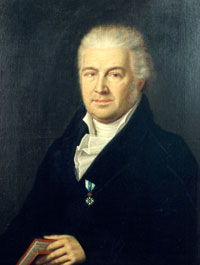Samuel Thomas von Sömmerring
Samuel Thomas von Sömmerring (28 January 1755 – 2 March 1830) was a German physician, anatomist, anthropologist, paleontologist, and inventor. Sömmerring is known for his pioneering work in the field of anatomy and for his contributions to the understanding of human physiology and the nervous system. His research and discoveries have had a lasting impact on the medical and scientific communities.
Early Life and Education[edit | edit source]
Samuel Thomas von Sömmerring was born in Thorn, Prussia (now Toruń, Poland) into a family with a strong medical background. His father was a respected physician, which influenced Sömmerring's early interest in medicine and anatomy. He pursued his medical studies at the University of Göttingen, where he was particularly influenced by the teachings of anatomist Johann Friedrich Blumenbach. In 1778, Sömmerring completed his doctoral dissertation on the cranial nerves, which laid the foundation for his future research in anatomy and neurology.
Career and Contributions[edit | edit source]
After completing his studies, Sömmerring held various academic positions, including a professorship at the University of Mainz. Throughout his career, he made significant contributions to different fields of science and medicine.
Anatomy and Physiology[edit | edit source]
Sömmerring's work in anatomy and physiology is perhaps his most enduring legacy. He made detailed studies of the sensory organs, particularly the eye and the ear, contributing to the understanding of their functions and structures. His work on the brain and nervous system was also groundbreaking. Sömmerring identified several structures in the brain, including the optic thalamus and the cranial nerves, enhancing the understanding of neural pathways and brain anatomy.
Anthropology and Paleontology[edit | edit source]
In addition to his medical research, Sömmerring had interests in anthropology and paleontology. He was one of the first to study human racial diversity from an anatomical perspective, attempting to classify human races based on cranial measurements. While some of his views are considered outdated today, his work contributed to the development of physical anthropology. Sömmerring also studied fossils and was involved in the early discussions on the nature of the dinosaur and other prehistoric creatures.
Inventions[edit | edit source]
Sömmerring was also an inventor. He is credited with the design of an early version of the electric telegraph in 1809, which used gold wires to represent the alphabet. Although his invention was not commercially successful, it represented an important step in the development of telecommunication.
Legacy[edit | edit source]
Samuel Thomas von Sömmerring's contributions to science and medicine were widely recognized during his lifetime. He was a member of several prestigious scientific societies and received numerous awards for his work. Today, he is remembered as one of the pioneers of modern anatomy and physiology, and his work continues to be studied and admired by scientists and historians alike.
Death[edit | edit source]
Sömmerring passed away on 2 March 1830 in Frankfurt am Main, Germany. His legacy lives on through his numerous publications and the continued relevance of his scientific discoveries.
Search WikiMD
Ad.Tired of being Overweight? Try W8MD's NYC physician weight loss.
Semaglutide (Ozempic / Wegovy and Tirzepatide (Mounjaro / Zepbound) available. Call 718 946 5500.
Advertise on WikiMD
|
WikiMD's Wellness Encyclopedia |
| Let Food Be Thy Medicine Medicine Thy Food - Hippocrates |
Translate this page: - East Asian
中文,
日本,
한국어,
South Asian
हिन्दी,
தமிழ்,
తెలుగు,
Urdu,
ಕನ್ನಡ,
Southeast Asian
Indonesian,
Vietnamese,
Thai,
မြန်မာဘာသာ,
বাংলা
European
español,
Deutsch,
français,
Greek,
português do Brasil,
polski,
română,
русский,
Nederlands,
norsk,
svenska,
suomi,
Italian
Middle Eastern & African
عربى,
Turkish,
Persian,
Hebrew,
Afrikaans,
isiZulu,
Kiswahili,
Other
Bulgarian,
Hungarian,
Czech,
Swedish,
മലയാളം,
मराठी,
ਪੰਜਾਬੀ,
ગુજરાતી,
Portuguese,
Ukrainian
Medical Disclaimer: WikiMD is not a substitute for professional medical advice. The information on WikiMD is provided as an information resource only, may be incorrect, outdated or misleading, and is not to be used or relied on for any diagnostic or treatment purposes. Please consult your health care provider before making any healthcare decisions or for guidance about a specific medical condition. WikiMD expressly disclaims responsibility, and shall have no liability, for any damages, loss, injury, or liability whatsoever suffered as a result of your reliance on the information contained in this site. By visiting this site you agree to the foregoing terms and conditions, which may from time to time be changed or supplemented by WikiMD. If you do not agree to the foregoing terms and conditions, you should not enter or use this site. See full disclaimer.
Credits:Most images are courtesy of Wikimedia commons, and templates, categories Wikipedia, licensed under CC BY SA or similar.
Contributors: Prab R. Tumpati, MD

